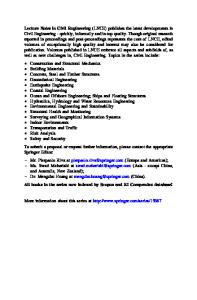Experimental study on mechanical properties and failure behaviour of the pre-cracked coal-rock combination
- PDF / 7,356,830 Bytes
- 15 Pages / 595.276 x 790.866 pts Page_size
- 2 Downloads / 408 Views
ORIGINAL PAPER
Experimental study on mechanical properties and failure behaviour of the pre-cracked coal-rock combination Jiangwei Liu 1 & Na Wu 2
&
Guangyao Si 3 & Mingxin Zhao 4
Received: 22 February 2020 / Accepted: 19 November 2020 # Springer-Verlag GmbH Germany, part of Springer Nature 2020
Abstract The mechanical property of roof is critically important for underground coal mining activities. The existence of hard roof that cannot cave naturally after coal extraction results in an unconsolidated goaf with large voids, and the sudden failure of this type of roof in uncontrolled manner will cause server windblast or rockburst hazard. To address this hazard, pre-existing fractures are created in roof by hydraulic fracturing or blasting to weaken the hard roof and promote its natural caving. The effectiveness of these roof weakening techniques is highly dependent on the geometry of pre-conditioned fractures and its impact on the mechanical behaviour of combined roof-coal strata, which has not been well-explored yet. Therefore, 21 groups of uniaxial compression testing on combined rock-coal specimens with pre-existing cracks were carried out, and the effect of fracture length and angle on the mechanical properties and failure modes of combined rock-coal strata were investigated. It can be concluded that longer cracks and/or cracks with angle closer to 30° tend to have the following characteristics. (1) The more gentle the stressstrain curve of the combined coal and rock tends to be, the larger the decrease range of its elastic modulus, peak strength and peak strain, and the smaller the strain interval corresponding to the elastic-plastic stage. The results show that the artificial fracture weakens the mechanical properties of composite coal and accelerates the process from micro-crack to macro failure. (2) When the specimen enters the plastic stage, the acoustic emission jumps sharply; the cumulative number of micro-cracks and the cumulative energy released during the whole loading process gradually decrease, and the number of micro-cracks and the released energy at the moment of failure also decrease gradually. (3) The crack-initiating stress for combined coal-rock specimens gradually decreases via one of three typical modes: preferential crack initiation of coal, simultaneous crack initiation of combined coal-rock and preferential crack initiation of rock, which also matches with coal failure, rock-coal failure and rock failure in the combined specimens. Thus, to promote the continuous fracture of the roof under loading, the length and orientation of the preconditioned cracks must be controlled and optimised. Keywords Combined coal-rock . Pre-existing fractures . Failure mode . Crack angle . Crack length
Introduction
* Na Wu [email protected] 1
College of Energy and Mining Engineering, Shandong University of Science and Technology, Qingdao 266590, China
2
State Key Laboratory of Coastal and Offshore Engineering, Dalian University of Technology, Dalian 116024, China
3
School of Minerals and En
Data Loading...











